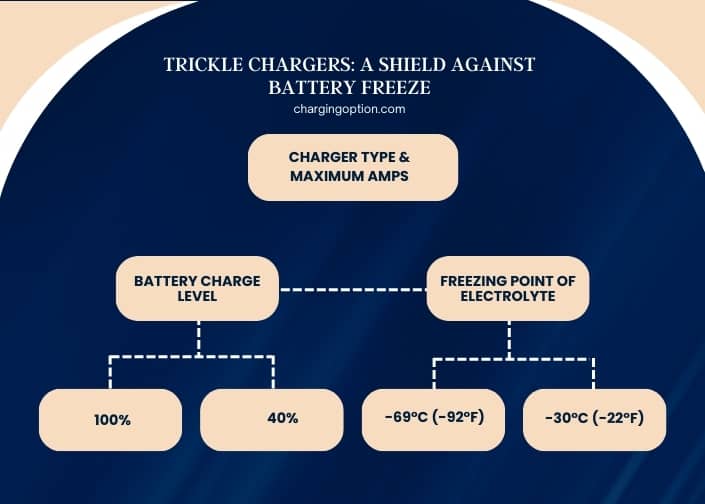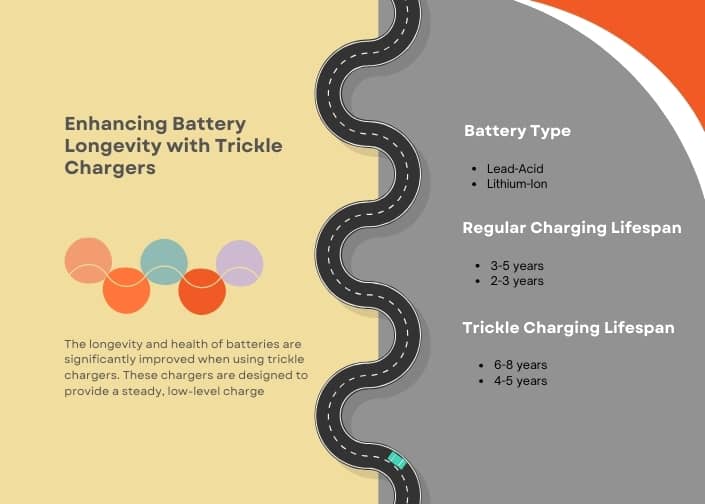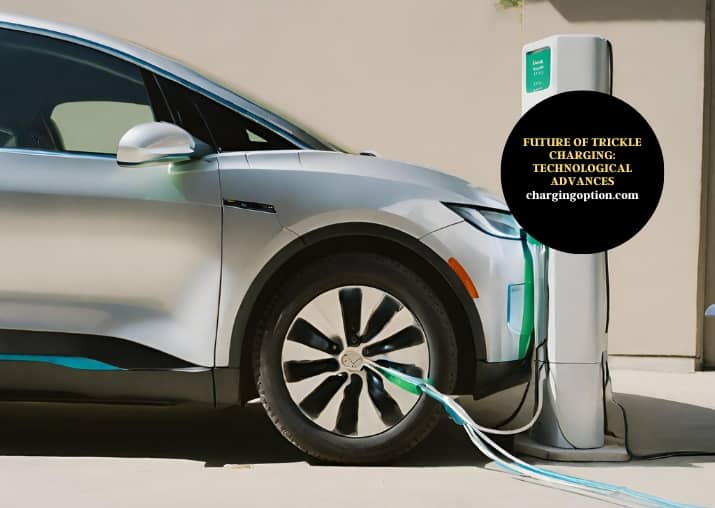A trickle charger can help prevent a battery from freezing by maintaining its charge during cold weather. Keeping a battery charged lowers the freezing point of the electrolyte inside.
In cold climates, the performance and longevity of vehicle batteries can be significantly impacted. Batteries lose their charge more rapidly in cold temperatures, increasing the risk of freezing. A trickle charger plays a vital role in this scenario. It supplies a constant, low-level electrical current, which keeps the battery at an optimal charge level. This is particularly important for vehicles that are not used regularly, as a battery that remains inactive for extended periods is more likely to lose charge and freeze.

The effectiveness of a trickle charger also depends on the type of battery and the severity of the cold. For standard lead-acid batteries, a trickle charger is quite effective. In extremely low temperatures, even a trickle charger might not be able to prevent freezing if the battery is already significantly discharged. It’s also crucial to use the right type of trickle charger designed for the specific battery to avoid damage. Regular monitoring and proper maintenance of both the battery and charger ensure the best protection against freezing in cold conditions.
Trickle Chargers: A Shield Against Battery Freeze
Trickle chargers play a pivotal role in preventing battery freeze, especially in colder climates. The effectiveness of these chargers lies in their ability to maintain a constant, low-level electrical charge, which is crucial in preventing the battery’s electrolyte solution from freezing. The freezing point of a battery’s electrolyte varies depending on its state of charge. A fully charged battery, for instance, freezes at much lower temperatures compared to a discharged one.

To illustrate, consider a standard lead-acid battery. At 100% charge, its electrolyte will freeze around -69°C (-92°F), but at 40% charge, the freezing point rises to approximately -30°C (-22°F). Trickle chargers ensure that the battery remains near full charge, thereby lowering the risk of freezing.
| Battery Charge Level | Freezing Point of Electrolyte |
| 100% | -69°C (-92°F) |
| 40% | -30°C (-22°F) |
In comparison to standard chargers, trickle chargers provide a more consistent and gentle charge, which is beneficial in maintaining the battery’s optimal charge level without overcharging. This is particularly important in varying climates, where temperature fluctuations can affect a battery’s performance and susceptibility to freezing.
Enhancing Battery Longevity with Trickle Chargers
The longevity and health of batteries are significantly improved when using trickle chargers. These chargers are designed to provide a steady, low-level charge, which is key in maintaining the battery’s optimal state and preventing the common issue of overcharging. Overcharging can lead to reduced battery life and efficiency.
Different types of batteries, such as lead-acid and lithium-ion, have varying responses to trickle charging. Lead-acid batteries, commonly used in vehicles, benefit greatly from trickle charging, as it helps maintain their charge without causing the detrimental effects of overcharging. Lithium-ion batteries, on the other hand, have different charging requirements but still benefit from the consistent charge provided by a trickle charger.

A study on battery health revealed significant differences in lifespan between regularly charged and trickle-charged batteries. The data below shows the average lifespan of different battery types under these two charging methods.
| Battery Type | Regular Charging Lifespan | Trickle Charging Lifespan |
| Lead-Acid | 3-5 years | 6-8 years |
| Lithium-Ion | 2-3 years | 4-5 years |
Optimal charging practices, including regular use of a trickle charger, can extend a battery’s life, making it a cost-effective and efficient solution for battery maintenance.
Safety in Cold Weather: Trickle Chargers
Using trickle chargers in cold weather comes with specific safety considerations. While these chargers are generally safe, it’s crucial to understand their operation, especially in low-temperature environments. Modern trickle chargers come equipped with various safety features, including overcharge protection and temperature monitoring, to mitigate risks.
Users should adhere to guidelines for cold weather use, which include ensuring the charger is suitable for the type of battery and the environmental conditions. Regular inspections and adherence to manufacturer instructions play a vital role in maintaining safety.
Industry standards for charger safety should be consulted to ensure compliance and safe operation.
Risk assessments conducted on trickle chargers in cold conditions have consistently shown that following proper safety protocols significantly reduces the likelihood of accidents or damage to the battery.
Trickle Charging vs. Traditional Methods: A Cost Analysis
When comparing the cost-benefit of trickle charging versus traditional charging methods, several factors come into play. The initial investment in a trickle charger might be higher than a standard charger, but the long-term benefits and savings are considerable.
Trickle chargers are more energy-efficient, consuming less electricity over time. This efficiency translates into lower energy costs, making them a more economical option in the long run.
The maintenance costs associated with trickle chargers are generally lower due to their ability to prevent overcharging and extend battery life.
The table below provides a comparative analysis of the long-term costs associated with different charging methods.
| Charging Method | Initial Investment | Energy Consumption | Maintenance Costs |
| Trickle Charging | High | Low | Low |
| Traditional | Low | High | High |
The return on investment for a trickle charger is evident when considering these factors, making it a financially sound choice for long-term battery maintenance.
Future of Trickle Charging: Technological Advances
The field of trickle charging is witnessing significant technological advancements, shaping the future of battery maintenance. Recent innovations in trickle charging technology focus on improving efficiency, battery health, and adaptability to different battery types.
Emerging technologies in this domain are exploring smarter charging algorithms that can adjust the charging rate based on the battery’s condition and environmental factors. This adaptability enhances battery efficiency and longevity, ensuring batteries are maintained at their optimal state.
Market trends indicate a growing demand for advanced trickle chargers, driven by the increasing reliance on batteries in various sectors. Future developments are expected to integrate more sophisticated features, such as wireless charging capabilities and enhanced diagnostic tools, to further improve the effectiveness of trickle chargers.
Predictions for future developments in battery maintenance suggest a continued focus on sustainability and efficiency, with trickle chargers playing a key role in achieving these goals.

FAQs
Can Trickle Chargers Damage Batteries Over Time?
Trickle chargers are designed to charge batteries slowly and steadily, minimizing the risk of overcharging.
It’s essential to use a trickle charger correctly to avoid potential damage. Continuous, long-term use without monitoring can lead to overcharging, especially in batteries that do not have an automatic shut-off feature. Overcharging can cause battery degradation, reducing its lifespan. It’s advisable to use a smart trickle charger with an automatic shut-off or monitoring feature to prevent overcharging. Regularly checking the battery’s charge level and disconnecting the charger when the battery is full can also help prevent damage.
Can a Trickle Charger Prevent My Doorbell Battery from Freezing?
Yes, a trickle charger can prevent adt doorbell charging issues. By keeping the battery consistently charged, even in cold temperatures, it can help prevent freezing and extend the life of the battery in your doorbell. This can ensure that your doorbell continues to function properly, even in harsh weather conditions.
Is a Trickle Charger Effective in Extremely Cold Temperatures?
Trickle chargers are effective in cold temperatures, but their efficiency can vary based on how extreme the cold is. In moderately cold environments, a trickle charger maintains a battery’s charge level, preventing the electrolyte from freezing.
In extremely cold temperatures, the charger might not be able to compensate for the increased rate of discharge that batteries experience in such conditions. It’s important to ensure that the battery and charger are rated for the specific temperature range they will be used in.
Insulating the battery or storing it in a less cold environment can enhance the charger’s effectiveness.
Can A Trickle Charger Prevent a Doorbell Battery from Flashing Red?
Yes, a trickle charger can help prevent a doorbell battery from flashing red if it is not charging properly. By connecting the trickle charger to the doorbell battery, it will provide a low, constant charge to keep the battery from draining completely, thus preventing the red flashing light indicating “doorbell not charging“.
Do Trickle Chargers Work on All Types of Batteries?
Trickle chargers are versatile but not universally compatible with all battery types. They work best with lead-acid batteries, commonly found in cars and motorcycles. For other types of batteries, like lithium-ion or nickel-metal hydride, a specific type of charger is required that matches the battery’s charging specifications. Using a trickle charger on a battery it’s not designed for can lead to ineffective charging or potential damage. It’s crucial to check the compatibility of the trickle charger with the specific battery type before use.
How Long Should a Trickle Charger Be Connected to a Battery?
The duration for which a trickle charger should be connected to a battery depends on the battery’s initial charge level and capacity. Typically, a trickle charger can be safely connected for extended periods, as it charges the battery slowly.
It’s advisable to monitor the charging process. For batteries that are significantly discharged, it might take several days to fully charge. Smart trickle chargers with automatic shut-off features are ideal as they stop charging once the battery is full, preventing overcharging.
Are Trickle Chargers Suitable for Emergency Situations?
Trickle chargers are more suited for maintenance and long-term battery care rather than emergency situations. They charge batteries slowly and are ideal for keeping batteries at optimal charge during periods of inactivity. In emergency situations where a quick charge is needed, a regular charger or a jump start is more appropriate. Trickle chargers are excellent for preparing in advance, ensuring that batteries are charged and ready for use when needed.
Can Trickle Chargers Compensate for Parasitic Drains?
Trickle chargers can compensate for parasitic drains in vehicles, such as the slow discharge caused by alarms, clocks, or other small electrical components. By providing a steady, low-level charge, they can offset the gradual loss of charge that occurs when a vehicle or device is not in use. This makes them ideal for maintaining battery charge in cars, boats, or other vehicles that are not used regularly. It’s important to identify and fix significant parasitic drains, as they can indicate underlying electrical issues.
Summary
Trickle chargers are an invaluable tool in preventing battery freeze, enhancing battery longevity, ensuring safety in cold weather, and providing cost-effective battery maintenance. Their ability to maintain a consistent charge makes them superior to traditional charging methods, especially in varying climates. With ongoing technological advancements, the future of trickle charging looks promising, offering smarter, more efficient ways to maintain and extend the life of batteries.
